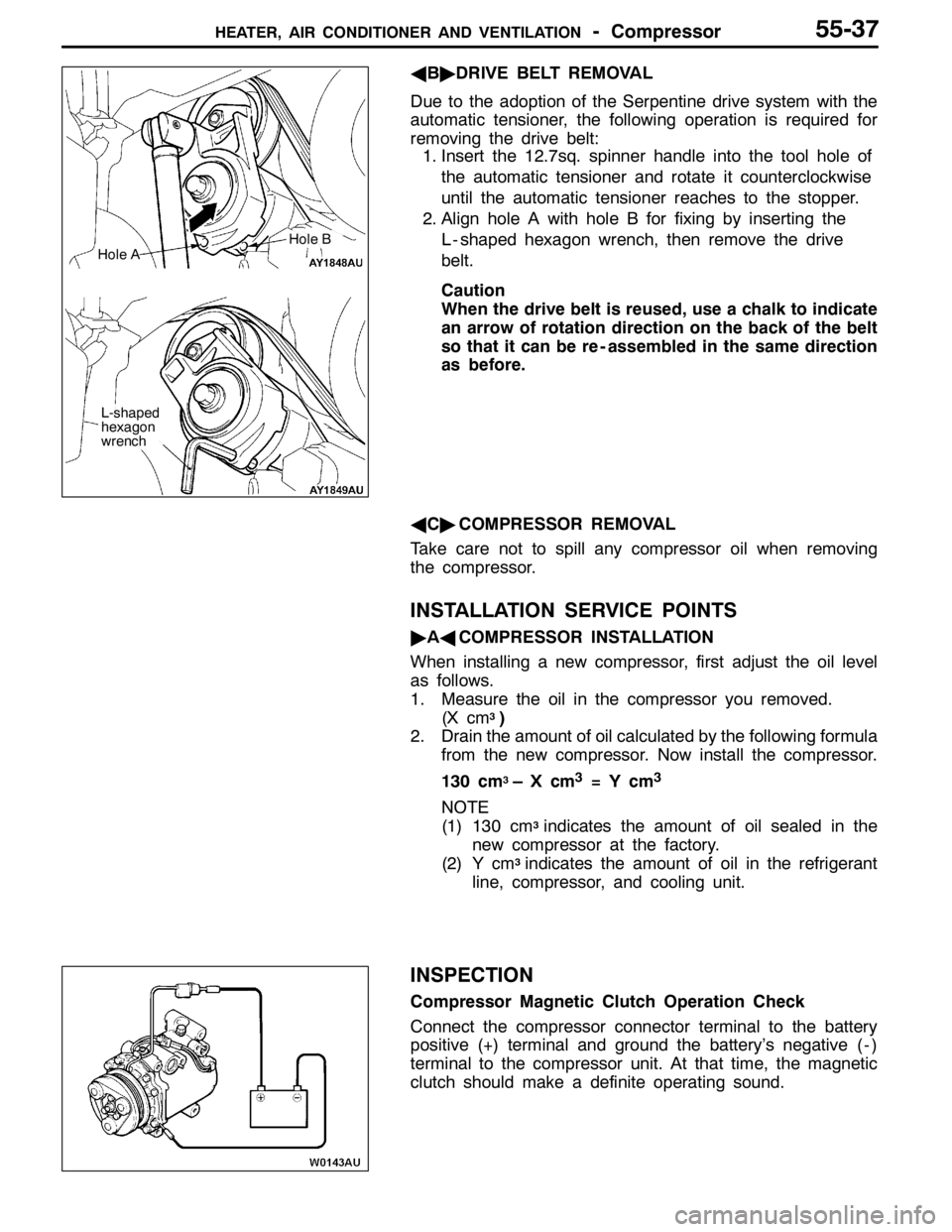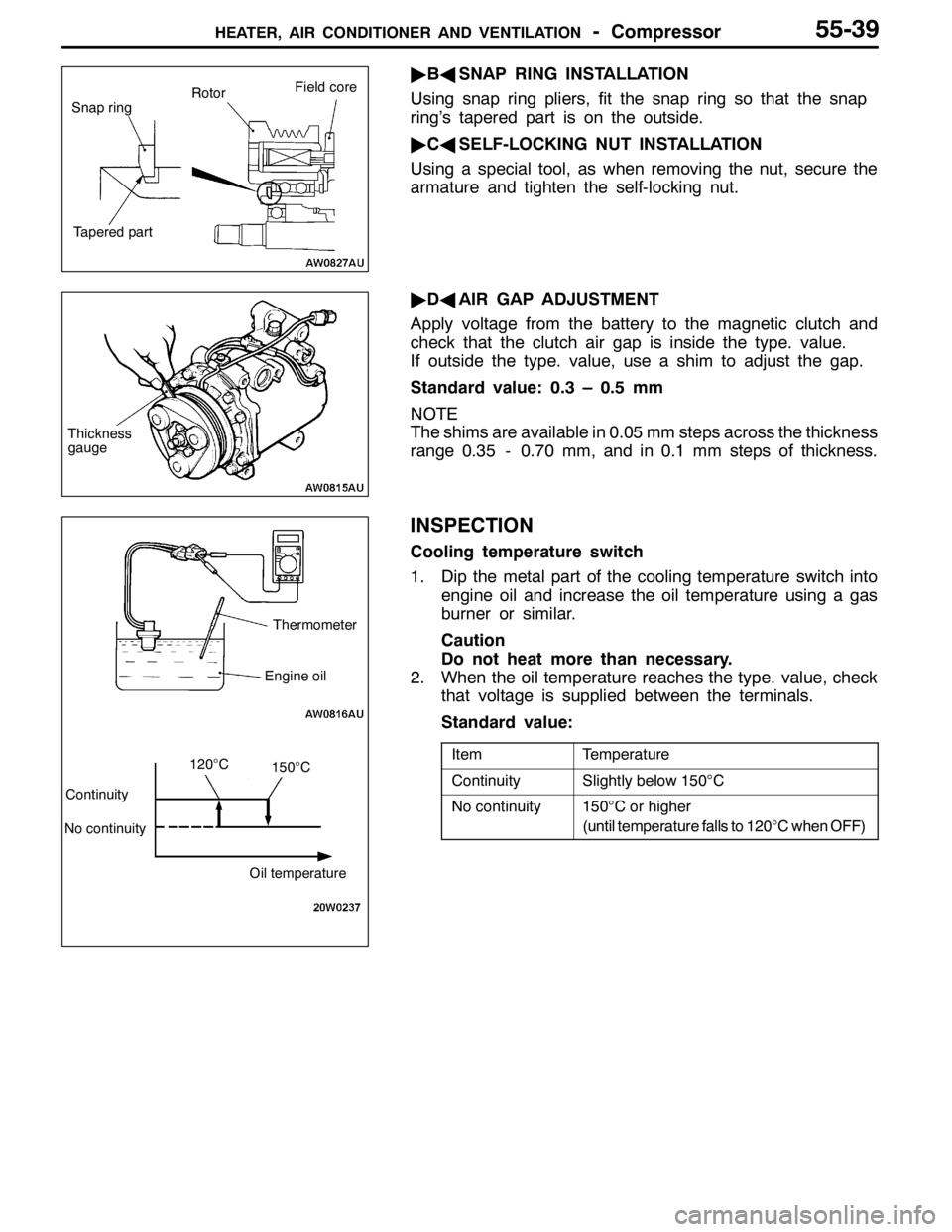Page 1435 of 1449
Resister, Blower Motor, Inside/outside
Air Changeover Damper MotorHEATER, AIR CONDITIONER AND VENTILATION-55-33
INSPECTION
Resister Check
Standard values:
Test terminalsStandard value (Ω)
HI - LO (between terminals 2 and 4)2.54
HI - ML (between terminals 2 and 1)1.24
HI - MH (between terminals 2 and 3)0.6
Blower Motor Check
Check that the motor is running when the battery voltage
is applied between the terminals. Check that the motor is
not producing any abnormal noise at that time.
Inside/Outside Air Changeover Damper Motor Check
Battery connection terminal lever
operationOperating the lever
467
Turn to cabin air side
Turn to outside air side
Battery connection terminal lever
operationOperating the lever
467
Turn to outside air side
Turn to cabin air side
Caution
When the lever is in the OFF position, no power is supplied.
Inside air
Outside air
Page 1436 of 1449

HEATER, AIR CONDITIONER AND VENTILATION-Evaporator and Air Thermo Sensor55-34
EVAPORATOR AND AIR THERMO SENSOR
REMOVAL AND INSTALLATION
Pre-removal and Post-installation Operations
DRefrigerant Draining and Refilling (Refer to P.55-16, 19.)
1 2
3
4
56
7 8
12±2 N·m
- Pipe coupling
O-ring
A/C compressor oil:
SUN PAG 56
1, 2
9
Disassembly steps
DGlove box (Refer to GROUP 52A –
Instrument Panel.)
DEngine-ECU (Refer to GROUP 14.)
AA"1. Suction pipe connection
AA"2. Liquid pipe B connection
AA"3. Expansion valve4. Expansion valve adapter
5. Joint duct
6. Evaporator cover
AB""AA7. Evaporator
8. Air thermo sensor clip
9. Air thermo sensor
REMOVAL SERVICE POINTS
AA"WHEN DISCONNECTING THE SUCTION PIPE,
LIQUID PIPE B, AND THE EXPANSION VALVE
To prevent the entry of dust or other foreign bodies, plug
the dismantled hose and the nipples of the expansion valves.
Caution
As the compressor oil and receiver are highly moisture
absorbent, use a non-porous material to plug the hose
and nipples.
Page 1437 of 1449
HEATER, AIR CONDITIONER AND VENTILATION-Evaporator, Air Thermo Sensor55-35
AB"EVAPORATOR REMOVAL
1. When removing the evaporator, cut and fold back the
dashboard pad as in the diagram. (The thickness of the
pad interferes with the removal of the evaporator.)
2. Remove the evaporator.
Caution:
Do not cut the upper side of the pad.
INSTALLATION SERVICE POINTS
"AAEVAPORATOR INSTALLATION
After installing the evaporator, glue the cut dashboard panel
pad with an adhesive agent.
INSPECTION
Air thermo sensor inspection
Measure the resistance between connector terminals 4 and
5 under at least two different temperatures. The resistance
values should generally match those in the graph.
NOTE
The temperature at the check should not exceed the range
in the graph.
Blower unit
Dashboard pad
Resistance
(kΩ)
Temperature(_C) 20
15
10
5
0
-10 0 1040
30
20
25
Page 1438 of 1449
HEATER, AIR CONDITIONER AND VENTILATION-Compressor55-36
COMPRESSOR
REMOVAL AND INSTALLATION
Before Removal
Refrigerant Draining (Refer to P.55-19.)After Removal
DRefrigerant Replenishing (Refer to P.55-16.)
DDrive Belt Tension Check (Refer to GROUP
11A – Engine Adjustment.)
25±4
N·m
2 4
1
- Pipe coupling
O ring
A/C compressor oil:
SUN PAG 56
1, 2
5
3
Removal steps
AA"1. Flexible suction hose connection
AA"2. Flexible discharge hose connection
AB"3. Drive beltAC""AA4. Compressor
5. Compressor bracket
REMOVAL SERVICE POINTS
AA"DISCONNECTION OF FLEXIBLE SUCTION HOSE
AND FLEXIBLE DISCHARGE HOSE
To prevent the entry of dust or other foreign bodies, plug
the dismantled hoses and compressor nipples.
Caution
As the compressor oil and receiver are highly moisture
absorbent, use a non-porous material to plug the hose
and nipples.
Page 1439 of 1449

HEATER, AIR CONDITIONER AND VENTILATION-Compressor55-37
AB"DRIVE BELT REMOVAL
Due to the adoption of the Serpentine drive system with the
automatic tensioner, the following operation is required for
removing the drive belt:
1. Insert the 12.7sq. spinner handle into the tool hole of
the automatic tensioner and rotate it counterclockwise
until the automatic tensioner reaches to the stopper.
2. Align hole A with hole B for fixing by inserting the
L - shaped hexagon wrench, then remove the drive
belt.
Caution
When the drive belt is reused, use a chalk to indicate
an arrow of rotation direction on the back of the belt
so that it can be re - assembled in the same direction
as before.
AC"COMPRESSOR REMOVAL
Take care not to spill any compressor oil when removing
the compressor.
INSTALLATION SERVICE POINTS
"AACOMPRESSOR INSTALLATION
When installing a new compressor, first adjust the oil level
as follows.
1. Measure the oil in the compressor you removed.
(X cm
3)
2. Drain the amount of oil calculated by the following formula
from the new compressor. Now install the compressor.
130 cm
3–Xcm3=Ycm3
NOTE
(1) 130 cm3indicates the amount of oil sealed in the
new compressor at the factory.
(2) Y cm
3indicates the amount of oil in the refrigerant
line, compressor, and cooling unit.
INSPECTION
Compressor Magnetic Clutch Operation Check
Connect the compressor connector terminal to the battery
positive (+) terminal and ground the battery’s negative ( - )
terminal to the compressor unit. At that time, the magnetic
clutch should make a definite operating sound.
Hole A
L-shaped
hexagon
wrench
Hole B
Page 1440 of 1449
HEATER, AIR CONDITIONER AND VENTILATION-CompressorHEATER, AIR CONDITIONER AND VENTILATION-Compressor55-38
DISASSEMBLY AND REASSEMBLY
1 2
3
4
5
6
16±1 N·m
9
7
8
Cooling temperature switch
dismantling steps
1. Snap ring
2. Cooling temperature switch
Magnetic clutch dismantling
procedure
"DADAir gap adjustmentAA""CA3. Self-locking nut
4. Armature
5. Shim
"BA6. Snap ring
7. Rotor
8. Snap ring
"AA9. Field core
ASSEMBLY SERVICE POINT
AA"DISMANTLING OF SELF-LOCKING NUT
ASSEMBLY SERVICE POINTS
"AAFIELD CORE ATTACHMENT
Line up the pin hole on the compressor unit with the field
core projection and attach.
MB991386
MB991367
Compressor
unit pin hole
Field core projection
Page 1441 of 1449

HEATER, AIR CONDITIONER AND VENTILATION-Compressor55-39
"BASNAP RING INSTALLATION
Using snap ring pliers, fit the snap ring so that the snap
ring’s tapered part is on the outside.
"CASELF-LOCKING NUT INSTALLATION
Using a special tool, as when removing the nut, secure the
armature and tighten the self-locking nut.
"DAAIR GAP ADJUSTMENT
Apply voltage from the battery to the magnetic clutch and
check that the clutch air gap is inside the type. value.
If outside the type. value, use a shim to adjust the gap.
Standard value: 0.3 – 0.5 mm
NOTE
The shims are available in 0.05 mm steps across the thickness
range 0.35 - 0.70 mm, and in 0.1 mm steps of thickness.
INSPECTION
Cooling temperature switch
1. Dip the metal part of the cooling temperature switch into
engine oil and increase the oil temperature using a gas
burner or similar.
Caution
Do not heat more than necessary.
2. When the oil temperature reaches the type. value, check
that voltage is supplied between the terminals.
Standard value:
ItemTemperature
ContinuitySlightly below 150°C
No continuity150°C or higher
(until temperature falls to 120°C when OFF)
Snap ringRotorField core
Tapered part
Thickness
gauge
Thermometer
Engine oil
Continuity
No continuity
Oil temperature
120°C150°C
Page 1442 of 1449
CondenserAssemblyand
Condenser Fan Assembly HEATER, AIR CONDITIONER AND VENTILATION-55-40
CONDENSER ASSEMBLY AND CONDENSER FAN ASSEMBLY
REMOVAL AND INSTALLATION
Pre-removal and Post-installation Operation
DRefrigerant Draining and Refilling (Refer to P.55-16, 19.)
DFront Bumper Removal and Installation (Refer to GROUP 51.)
12
34
Pipe coupling
O-ring
A/C compressor oil:
SUN PAG 56
5, 6
5
4.9�¶0.9 N��m
7
9
8 6
Fan motor assembly removal steps
AA"1. Fan motor and shroud assembly
2. Fan
3. Motor assembly
4. Fan shroud
Condenser assembly removal steps
DAir cleaner (Refer to GROUP 15.)
DRefrigerant draining and refilling
(Refer to P55A-16,19.)
AB"5. Flexible discharge hose connection
AB"6. Liquid pipe A connection
7. Condenser assembly
8. Clamp
9. Receiver
REMOVAL SERVICE POINTS
AA"FAN MOTOR AND SHROUD ASSEMBLY
REMOVAL
1. Remove the intercooler mounting bolts/nuts and pull the
intercooler forward.
2. Move the fan motor/shroud assembly upward for removal.